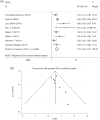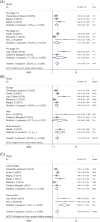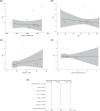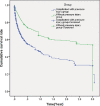The relationship between pressure injury complication and mortality risk of older patients in follow-up: A systematic review and meta-analysis
- PMID: 31606950
- PMCID: PMC7949299
- DOI: 10.1111/iwj.13243
The relationship between pressure injury complication and mortality risk of older patients in follow-up: A systematic review and meta-analysis
Abstract
Pressure injuries (PIs) have now become a common complication of the elderly patients. Some studies have observed that pressure injuries may increase mortality, but this area of evidence has not been evaluated and summarised. The aim of this study was to compare the mortality of patients with pressure injuries and those without pressure injuries. A meta-analysis of observational studies was performed. PubMed, Cochrane Library, Embase, and Web of Science were searched up to April 2019. Studies about mortality among the elderly patients with and without pressure injuries were included. Methodological quality was assessed by the Newcastle-Ottawa Scale (NOS). The fixed effect or random effect model was determined by the test of heterogeneity. The subgroup analysis was performed based on the pressure injuries stages, the region, and the type of study design. The meta-regression analysis was performed to investigate the relationship between the mortality and patients' enrolled year, average age, the incidence of pressure injuries, and gender ratio. The sensitivity analysis was used to explore the impact of an individual study by excluding one at a time. The hazard ratio (HR) and 95% confidence intervals (CIs) in terms of the comparison of two groups were extracted for meta-analysis. A survival curve between two groups by individual patient-level was drew. Eight studies with 5523 elderly patients were included in the analysis. Follow-up periods for the included studies ranged from about 0.5 to 3 years. The elderly patients who complicated with pressure injuries had a higher risk of death. The pooled HR was 1.78 (95% CI 1.46-2.16). A funnel plot showed no publication bias. Further subgroup analysis showed that HR values for the patient stage 3 to 4 pressure injuries (HR:2.41; 95% CI:1.08-5.37) were higher than stage 1-4 and 2-4 pressure injuries (HR: 1.66; 95% CI: 1.35-2.05; HR: 1.74; 95% CI: 1.16-2.60). The meta-regression analysis found that patients' enrolled year, average age, the incidence of pressure injuries, and gender ratio were not the sources of heterogeneity. Sensitivity analyses showed that the outcomes of the study did not change after removing the Onder's article. The survival curve at the individual patient-level also indicated that patients complicated with pressure injuries significantly increased the risk of death (HR: 1.958; 95% CI: 1.79-2.14) in elderly patients. Our meta-analysis indicated that patients complicated with pressure injuries are estimated to have a two times higher risk on mortality compared with patients without pressure injuries during the 3 years follow-up period. Particular attention should be given to the elderly patients who are at higher risk for mortality.
Keywords: meta-analysis; mortality; older patients; pressure injuries.
© 2019 Medicalhelplines.com Inc and John Wiley & Sons Ltd.
Conflict of interest statement
The authors declare no potential conflict of interest.
Figures





References
-
- Feuchtinger J, Halfens RJ, Dassen T. Pressure ulcer risk factors in cardiac surgery: a review of the research literature. Heart Lung. 2005;34(6):375‐385. - PubMed
-
- Aljezawi M, Tubaishat A. Pressure injuries among hospitalized patients with cancer: prevalence and use of preventive interventions. J Wound Ostomy Continence Nurs. 2018;45(3):227‐232. - PubMed
-
- Vanderwee K, Clark M, Dealey C, Gunningberg L, Defloor T. Pressure ulcer prevalence in Europe: a pilot study. J Eval Clin Pract. 2007;13(2):227‐235. - PubMed
-
- Bansal C, Scott R, Stewart D, Cockerell CJ. Decubitus ulcers: a review of the literature. Int J Dermatol. 2005;44(10):805‐810. - PubMed
Publication types
MeSH terms
Grants and funding
LinkOut - more resources
Full Text Sources
Medical
Miscellaneous

